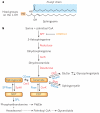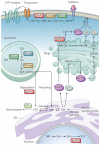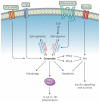Sphingolipid metabolites in inflammatory disease
- PMID: 24899305
- PMCID: PMC4320971
- DOI: 10.1038/nature13475
Sphingolipid metabolites in inflammatory disease
Abstract
Sphingolipids are ubiquitous building blocks of eukaryotic cell membranes. Progress in our understanding of sphingolipid metabolism, state-of-the-art sphingolipidomic approaches and animal models have generated a large body of evidence demonstrating that sphingolipid metabolites, particularly ceramide and sphingosine-1-phosphate, are signalling molecules that regulate a diverse range of cellular processes that are important in immunity, inflammation and inflammatory disorders. Recent insights into the molecular mechanisms of action of sphingolipid metabolites and new perspectives on their roles in regulating chronic inflammation have been reported. The knowledge gained in this emerging field will aid in the development of new therapeutic options for inflammatory disorders.
Figures




References
-
- Thudichum JLW. A Treatise on the Chemical Constitution of Brain. Bailliere and Cox; 1884.
-
- Hannun YA, Obeid LM. Principles of bioactive lipid signalling: lessons from sphingolipids. Nature Rev. Mol. Cell Biol. 2008;9:139–150. - PubMed
-
- Brinkmann V, et al. Fingolimod (FTY720): discovery and development of an oral drug to treat multiple sclerosis. Nature Rev. Drug Discov. 2010;9:883–897. - PubMed
Publication types
MeSH terms
Substances
Grants and funding
LinkOut - more resources
Full Text Sources
Other Literature Sources

